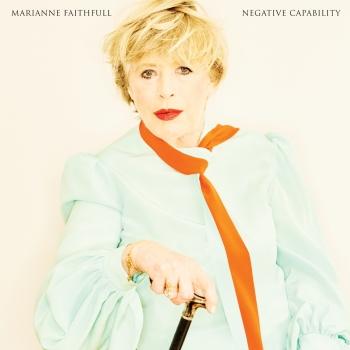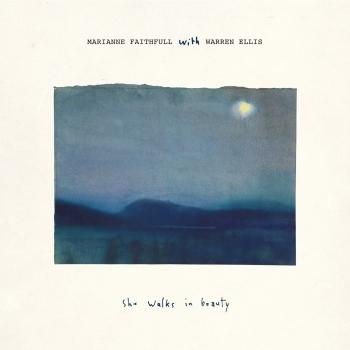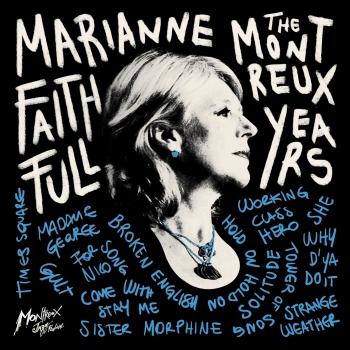
Marianne Faithfull: The Montreux Years (Live) Marianne Faithfull
Album Info
Album Veröffentlichung:
2021
HRA-Veröffentlichung:
27.08.2021
Label: BMG Rights Management (UK) Ltd
Genre: Vocal
Subgenre: Vocal Pop
Interpret: Marianne Faithfull
Das Album enthält Albumcover
Entschuldigen Sie bitte!
Sehr geehrter HIGHRESAUDIO Besucher,
leider kann das Album zurzeit aufgrund von Länder- und Lizenzbeschränkungen nicht gekauft werden oder uns liegt der offizielle Veröffentlichungstermin für Ihr Land noch nicht vor. Wir aktualisieren unsere Veröffentlichungstermine ein- bis zweimal die Woche. Bitte schauen Sie ab und zu mal wieder rein.
Wir empfehlen Ihnen das Album auf Ihre Merkliste zu setzen.
Wir bedanken uns für Ihr Verständnis und Ihre Geduld.
Ihr, HIGHRESAUDIO
- 1 Madame George (Live - Montreux Jazz Festival 1995) 06:30
- 2 Broken English (Live - Montreux Jazz Festival 2009) 08:05
- 3 Times Square (Live - Montreux Jazz Festival 2002) 03:33
- 4 Guilt (Live - Montreux Jazz Festival 1999) 05:00
- 5 Song for Nico (Live - Montreux Jazz Festival 2002) 04:37
- 6 Come and Stay with Me (Live - Montreux Jazz Festival 1999) 03:00
- 7 Sister Morphine (Live - Montreux Jazz Festival 2005) 08:11
- 8 She (Live - Montreux Jazz Festival 1995) 03:39
- 9 Hold On Hold On (Live - Montreux Jazz Festival 2009) 02:53
- 10 Solitude (Live - Montreux Jazz Festival 2009) 04:58
- 11 Working Class Hero (Live - Montreux Jazz Festival 1999) 05:49
- 12 Tower of Song (Live - Montreux Jazz Festival 1999) 04:36
- 13 Strange Weather (Live - Montreux Jazz Festival 2005) 05:21
- 14 Why D'ya Do It? (Live - Montreux Jazz Festival 1995) 06:35
Info zu Marianne Faithfull: The Montreux Years (Live)
Die großartige und unvergleichliche Marianne Faithfull hat zwischen 1995 und 2009 fünf legendäre Konzerte beim Montreux Jazz Festival gegeben. Jedes dieser historischen Konzerte wurde aufgezeichnet. Marianne Faithfull Name ist ein Synonym für die Authentizität, die Kunstfertigkeit und die Individualität des Festivals, was mit dieser Kollektion gefeiert werden soll.
Die Montreux-Jahre verkörpern den Geist des Montreux Jazz Festivals und das Vermächtnis seines beliebten Gründers Claude Nobs. Nobs weigerte sich, bei der Qualität Kompromisse einzugehen oder sich mit etwas anderem als dem Besten zufriedenzugeben, und dieses Ethos lebt in der hervorragenden Qualität der Aufnahmen fort, die in The Montreux Years zusammengestellt wurden. Das Mastering wurde von Tony Cousins in den legendären Londoner Metropolis Studios durchgeführt, wobei MQA integriert wurde, um den Originalsound dieser besonderen Live-Auftritte einzufangen. Ähnlich wie bei den ersten Alben der Reihe, Nina Simone und Etta James, werden die Alben von Marianne Faithfull und Muddy Waters von exklusiven Liner Notes und bisher unbekannten Fotografien begleitet.
Marianne Faithfull ist mit ihrem rohen, vielseitigen stimmlichen Talent und ihrem Charisma sofort erkennbar und seit vielen Jahren eine Freundin des Montreux Jazz Festivals. Über einen Zeitraum von fast 15 Jahren war sie fünfmal auf dem Festival zu sehen: 1995, 1999, 2002, 2005 und 2009. "Marianne Faithfull: The Montreux Years", ihr erstes Live-Album seit über 10 Jahren, beginnt mit einer bezaubernden Interpretation von Van Morrisons Madame George. Diese wurde am 10. Juli 1995 live im Auditorium Stravinski aufgenommen, wo ihre kraftvolle Bandbreite und unbeirrbare Dynamik sofort sichtbar werden.
Fans von Faithfull können in diese einzigartigen Aufnahmen eintauchen, die mehrere Songs ihres gefeierten Albums Broken English enthalten, wie eine elektrisierende Darbietung des Titeltracks Broken English, das treibende Guilt und John Lennons mitreißende Hymne Working Class Hero. Währenddessen fängt die eindringliche Sensibilität von Strange Weather, live im Casino Barrière am 6. Juli 2005 aufgenommen, die unendlichen Tiefen von Faithfulls brutaler Schönheit ein.
strong>Marianne Faithfull
Digitally remastered von Tony Cousins in den legendären Londoner Metropolis Studios
Zur Info: wir bieten dieses Album in der nativen Abtastrate von 48kHz, 24-Bit an. Die uns zur Verfügung gestellte 96kHz-Version wurde hochgerechnet und bietet keinen hörbaren Mehrwert!
Marianne Faithfull
A beautiful and articulate individual in the London scene of the 1960s, Marianne Faithfull was the product of her unusual background as the convent school-educated daughter of an English MI6 spy father and dancer mother from the Austro-Hungarian von Sacher-Masoch family.
Spotted, in 1964 at the age of 17, by The Rolling Stones’ manager Andrew Loog Oldham and finding herself only three months later a Top 10 pop star with her evocative reading of Jagger/Richards’ As Tears Go By – she has lived a wholly eventful life and produced a wide and varied catalogue of albums.
Beginning with the wistful folk and baroque pop of her mid-1960s work, Marianne ventured into darker territory in 1969 with Sister Morphine, a classic collaboration with Jagger/Richards which (as the b-side of her Something Better single) caused something of a controversy. Misinterpreted as a pro-drug song – when in reality it imagined a man in hospital dying after a car crash – the record was pulled from record shop shelves after two days.
The incident was emblematic of the way the newspapers unfairly vilified Marianne after the infamous bust at Keith Richards’ Redlands home in 1967. Hounded and cornered by the media, she admits now that she took solace in heroin, mistaking William Burroughs’ The Naked Lunch as something of a guide for life. “I took it absolutely for real,” Marianne laughs. “Later William said to me, ‘Marianne…that was fiction. It was not meant to be taken as a textbook of life and certainly not by you.’ I said, ‘Oh…’”
After a painful 1970s in which Marianne’s career was derailed by her personal difficulties, the singer made a spectacular return with her post-punk masterpiece, Broken English in 1979. Veering from the heartbreaking The Ballad Of Lucy Jordan to the enraged neo-reggae outbursts of Why D’Ya Do It, it was an album which found Marianne painting herself entirely in her own light and seizing absolute control of her creativity. Broken English was also the first Marianne Faithfull album to showcase her changed voice, which was variously described as “whisky-soaked” and “nicotine-stained”.
In the wake of Broken English there followed a series of albums with standouts almost too numerous to list: the torch songs of experience that made up Strange Weather (1987), the dreamlike sonic scapes of the Angelo Badalamenti-produced A Secret Life (1995), the dramatic, masterful tribute to Kurt Weill in The Seven Deadly Sins (1998). Post the millennium, Marianne has worked with a new generation of artists to achieve her creative vision, including Beck, Jarvis Cocker and Billy Corgan on 2002’s Kissin Time, Damon Albarn, Nick Cave and PJ Harvey on 2005’s Before The Poison, and Antony Hegarty and Rufus Wainwright on Easy Come Easy Go in 2008. 2011’s Horses And High Heels was a stirring set of songs overseen by her friend and longstanding collaborator, US producer Hal Willner.
In 2014, the 50th anniversary of the beginning of her recording career, Marianne released Give My Love To London. Produced by Rob Ellis and Dimitri Tikovoi and mixed by Flood, it featured an impressive roll call of studio collaborators including Adrian Utley (Portishead), Brian Eno, Ed Harcourt and Warren Ellis & Jim Sclavunos (The Bad Seeds). Songwriting contributors and co-conspirators – with Marianne penning the majority of the lyrics – include Nick Cave, Roger Waters, Steve Earle, Tom McRae and Anna Calvi.
Give My Love To London was all the more extraordinary given that it was written in the aftermath of an accident Marianne suffered in summer 2013 in Los Angeles, breaking her sacrum bone in four places. As a result, she found herself laid up for six months recovering in Paris, with little else to do but write songs, giving her the longest period of pre-production she has enjoyed for any of her albums. Once the album was recorded Marianne took a short holiday, during which she fractured her hip resulting in emergency surgery….and a prolonged recovery due to theatre-induced infection.
Despite the health complications Marianne returned to the stage for a world tour and was the subject of a luxury photo book Marianne Faithfull: A Life On Record edited by herself and Francois Ravard, published by Rizzoli, featuring iconic images of the singer by major photographers including Helmut Newton, David Bailey, Ellen Von Unwerth, Bruce Weber, Cecil Beaton and Robert Mapplethorpe.
‘Negative Capability’ is Marianne Faithfull’s 21st album and the most emotionally powerful of her 54-year recording career. Facing down arthritis and bolstered by collaborators including Warren Ellis, Nick Cave, Rob Ellis, Ed Harcourt and Mark Lanegan, ‘Negative Capability’ is charged with brutal honesty and autobiographical reflection as she addresses losing old friends, her loneliness living in her adopted city of Paris, and love.
Driven by her supernatural reinterpretative skills, florid lyricism, battle against the pain she lives with, and realised with her stellar group of musicians at La Frette studios near Paris, ‘Negative Capability’ is Marianne’s unflinchingly honest and relentlessly beautiful late-life masterpiece. The stark emotional heft, exquisitely framed by ornately sensitive musical backdrops can only be likened to the late-life works by Johnny Cash or Leonard Cohen.
Remarkably, at the same time as her music career, down the years Marianne Faithfull has enjoyed a parallel career as an actress, stretching from her 1967 debut in Chekhov’s Three Sisters and her acclaimed and haunting portrayal of Ophelia in Hamlet, through films including The Girl On The Motorcycle, Lucifer Rising, Marie Antoinette and Irina Palm. In addition, she has produced two candid, riveting autobiographies, Faithfull and Memories, Dreams and Reflections.
Dieses Album enthält kein Booklet














